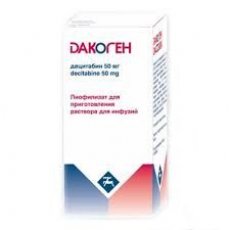Medical expert of the article
New publications
Preparations
Dakogen
Last reviewed: 03.07.2025

All iLive content is medically reviewed or fact checked to ensure as much factual accuracy as possible.
We have strict sourcing guidelines and only link to reputable media sites, academic research institutions and, whenever possible, medically peer reviewed studies. Note that the numbers in parentheses ([1], [2], etc.) are clickable links to these studies.
If you feel that any of our content is inaccurate, out-of-date, or otherwise questionable, please select it and press Ctrl + Enter.

Dacogen is an antitumor drug. Its main action is aimed at reducing some biochemical processes that are vital for the life and development of malignant organisms.
Indications Dakogen
Dacogen is prescribed for myelodysplastic syndrome. This disease is characterized by a decrease in certain types of cells in the blood, impaired bone marrow function, and an increased risk of developing acute leukemia.
Pharmacodynamics
Dacogen has a strong effect on the DNA enzyme - it reduces its activity, which leads to the suspension or complete destruction of cancer cells in the blood. The drug overcomes drug resistance, facilitates the immune response.
The maximum manifestation of Dacogen's action is observed after the cell independently reaches the S phase (DNA synthesis).
Pharmacokinetics
Dacogen is excreted by the kidneys, presumably as metabolites. The active substance is decitabene, less than 1% is excreted unchanged in the urine.
In the later stages of the disease, extrahepatic metabolism is observed when the drug is eliminated from the body. On average, the half-life is about half an hour.
After the IV drip, the concentration of the active substance in the blood increased and decreased in two phases; the drug shows extremely low binding to blood proteins (less than 1%).
The drug is metabolized primarily in the liver, as well as in the superficial layer of the intestine, granulocytes, and blood plasma.
Laboratory studies in test tubes allowed specialists to assume that decitabine is not the basis of the liver enzyme P450.
The pharmacokinetic properties of Dacogen have not been studied in patients with hepatic or renal impairment, and the effects of the drug on age or gender have not been studied.
Dosing and administration
Dacogen is usually prescribed in one of two regimens, each consisting of four cycles. In practice, long-term therapy with Dacogen may be required for complete or partial symptom reduction (duration of therapy may continue as long as the therapeutic effect of the drug is maintained).
After 4 cycles of therapy, the specialist may note the absence of positive dynamics in the treatment. If it is not possible to normalize blood parameters (platelet levels, neutrophils, etc.) or the disease progresses, alternative treatment is prescribed.
Each cycle involves administering the drug over several consecutive days (five or three days). Dacogen is administered intravenously using a drip.
With a five-day dosing regimen, the drug is administered at a dose of 20 mg (the patient will receive 5 doses per cycle), the cycle is repeated every 4 weeks; with a three-day regimen, 15 mg is administered every 8 hours (the patient will receive 9 doses per cycle), the cycle is repeated every six weeks.
At the beginning of treatment, a blood test may show a deficiency of some cells.
In old age, the dosage is usually the same. Depending on the tests and the patient's condition, the doctor may adjust the dosage of Dacogen.
 [ 15 ]
[ 15 ]
Use Dakogen during pregnancy
Dacogen is contraindicated for pregnant and lactating women, as it can provoke various disorders of embryonic development.
Contraindications
Dacogen is contraindicated in case of hypersensitivity to some components of the drug. Also, Dacogen treatment is not prescribed to children under 18 years of age.
 [ 12 ]
[ 12 ]
Side effects Dakogen
Dacogen may cause sleep disturbances, dizziness, headaches, decreased sensitivity, nausea, bowel disorders, vomiting, abdominal pain, rashes on the skin and mucous membranes, indigestion, fever, swelling at the injection site, bloating.
Also, therapy with Dacogen may be complicated by the development of pneumonia, pharyngitis, wheezing in the lungs, suffocation. After the drug, simple herpes, candidiasis, pain in the joints, lower back, etc. may develop.
Treatment may cause a decrease in the level of neutrophils, platelets, leukocytes and other blood cells, a decrease in sugar, albumin, magnesium, potassium in the blood, and an increased level of urea.
Dacogen can cause urinary tract infections, septic shock, sinusitis, and nosebleeds.
Interactions with other drugs
Dacogen increases the effect of other antitumor drugs, and a decrease in platelet levels may be observed. The combination of Dacogen with tamoxifen leads to bleeding and accumulation of large amounts of blood between the meninges.
When prescribing combination therapy, the patient is closely monitored to promptly identify possible negative reactions.
Storage conditions
Dacogen must be stored in its entire package, in a place where it is not exposed to sunlight or moisture. Dacogen solution dissolved in cold water is stored at a temperature of 2 to 8 0 C for no more than 7 hours.
The storage temperature of the drug should not exceed 30 0 C.
The drug must be kept out of the reach of children.
Special instructions
Dacogen can cause a significant decrease in the level of platelets and granulocytes in the blood, so before starting treatment and subsequently before each new cycle, the doctor should prescribe a general blood test to monitor the therapeutic as well as toxic effects of the drug.
Attention!
To simplify the perception of information, this instruction for use of the drug "Dakogen" translated and presented in a special form on the basis of the official instructions for medical use of the drug. Before use read the annotation that came directly to medicines.
Description provided for informational purposes and is not a guide to self-healing. The need for this drug, the purpose of the treatment regimen, methods and dose of the drug is determined solely by the attending physician. Self-medication is dangerous for your health.

